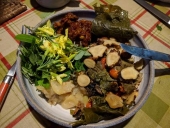








A well defined problem is already half solved.




 )
) 1
1




Jeff Millar wrote:
Found this, it's a little more conventional. Hope it helps. My turkeys and chickens are crazy about mulberries.
http://nutritiondata.self.com/facts/fruits-and-fruit-juices/1961/2
 1
1








On the border of Zones 5 & 6 on the last 2 acres of what was once a large farm. Flat, flat and more flat!








On the border of Zones 5 & 6 on the last 2 acres of what was once a large farm. Flat, flat and more flat!









. Per 100 g, the fruit is reported to contain 87.5 g water, 1.5 g protein, 0.49 g fat, 8.3 g carbohydrates, 1.4 g fiber, 0.9 g ash,
http://www.pfaf.org/user/Plant.aspx?LatinName=Morus%20alba




White mulberry as chicken forage is as good as a double crop of grain. It is 17% protein. The mulberry crop is a very good chicken food for the period of bearing in which it occurs, and beyond it; because the chickens are getting seed long after the mulberries are gone.
On the border of Zones 5 & 6 on the last 2 acres of what was once a large farm. Flat, flat and more flat!








Suzie Browning wrote:
Last year I froze mulberries to feed in the winter but with the small crop I had this year I won't be able to. Looks like it would have been better (more nutritious) to dry them instead.




Suzie Browning wrote: Do you know of anyone who has attempted to feed them dry leaves (whole, crushed, powdered?) in the winter (perhaps mixed with something else)?
Permaguy, have you considered adding meal worms or other insects to your tool?





Suzie Browning wrote:
I read this thread a couple of days ago and kept thinking to myself, but don't mulberries have 17% protein?
I finally found a reference on permacultre.org where Bill Mollison states White Mulberry is 17% Protein. Is this just white mulberries or am I misreading the data you've show?
 1
1




 1
1




 1
1




Jonathan Byron wrote:One of the major nutritional benefits of mulberries for humans will not be found in most reductionist discussions ... the anthocyanin pigments (red/purple/blue/black) influence the body in many desirable ways, but are not accounted for in the 1950s thinking that is limited to protein/carbs/fats/vitamins/minerals. Anthocyanins benefit blood sugar control, inflammation, blood pressure, and dozens of other real factors, but to a reductionist, mulberries are 'mostly sugar' and are though of as being little different than sugar candy.
 1
1




Working toward a food forest and self sufficiency in Western Oregon.




Jd

|
Those who dance are thought mad by those who hear not the music. This tiny ad plays the bagpipes:
Binge on 17 Seasons of Permaculture Design Monkeys!
http://permaculture-design-course.com
|


